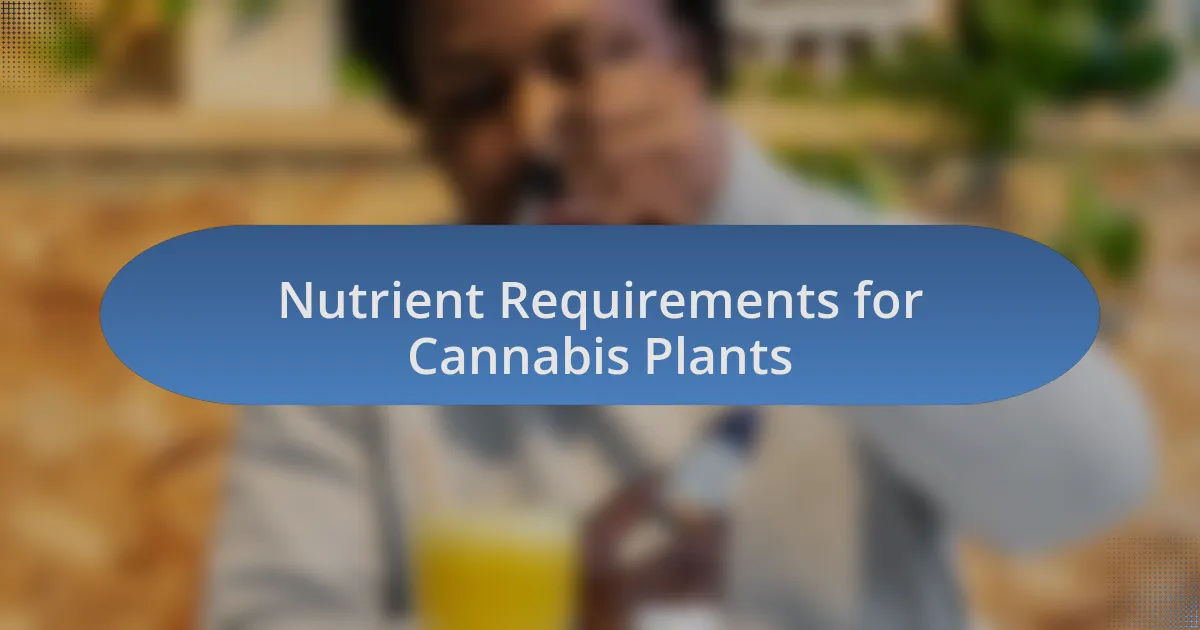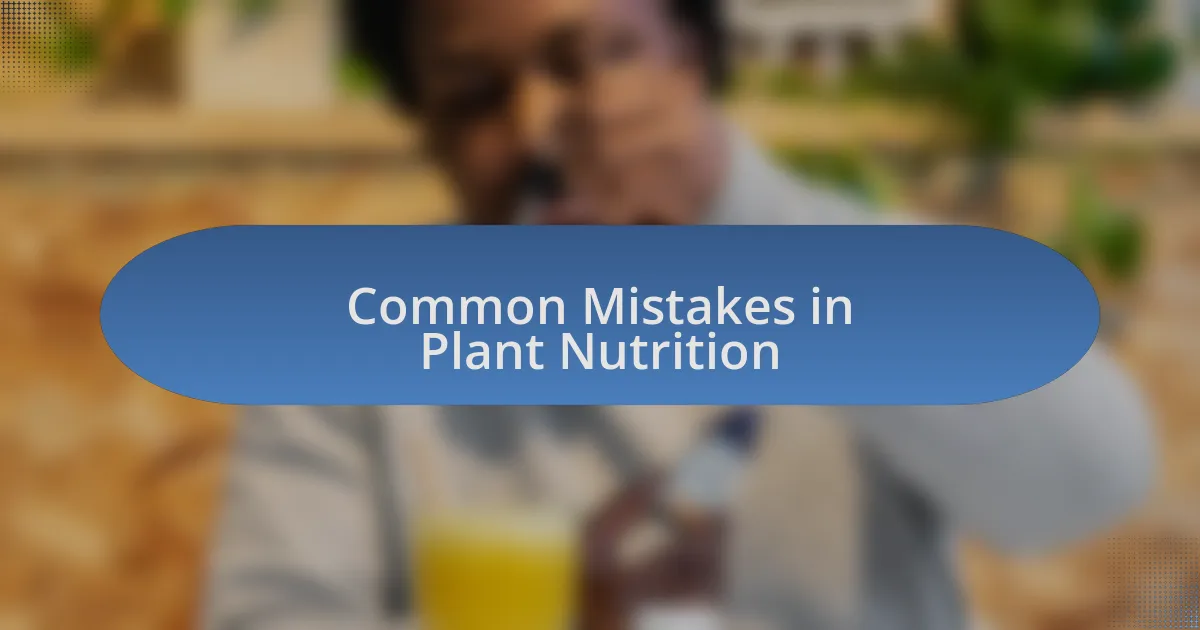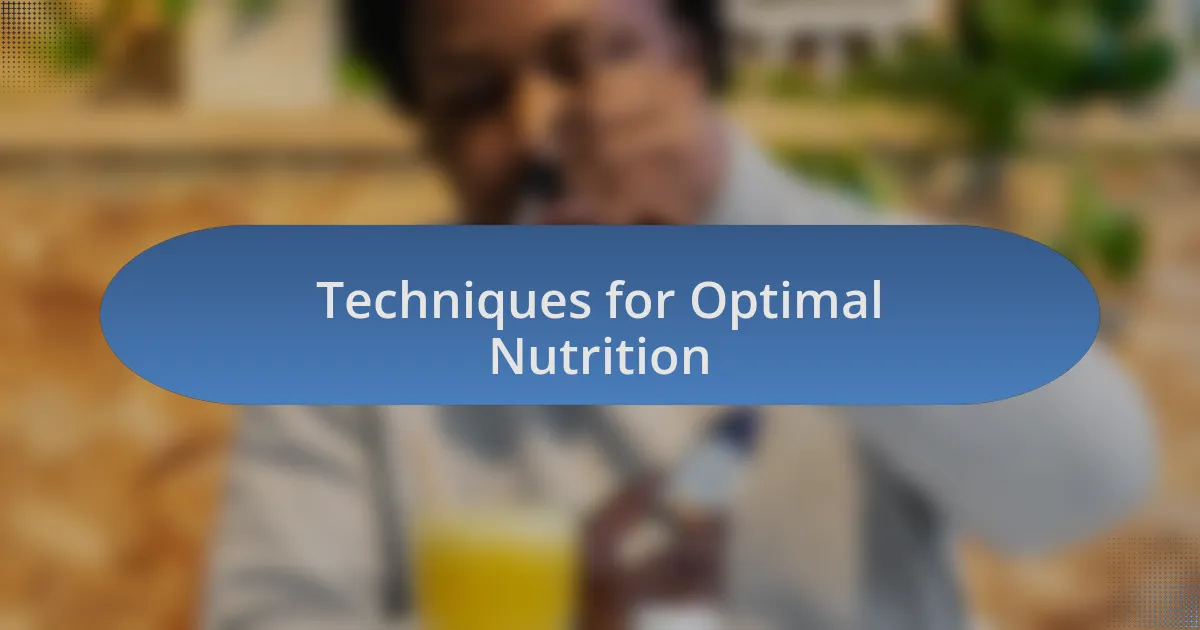Key takeaways:
- Cannabis requires a balanced intake of macronutrients (NPK) and micronutrients tailored to specific growth stages for optimal health and yield.
- Common mistakes include overapplication of nutrients, neglecting pH levels, and applying a one-size-fits-all approach to nutrient solutions.
- Incorporating organic amendments and establishing a tailored feeding schedule can enhance nutrient uptake and plant vitality.
- Listening to plant cues and building a supportive community among growers are crucial for continuous learning and improvement in cultivation practices.

Understanding Cannabis Plant Nutrition
Cannabis plant nutrition is a fascinating subject that encompasses the essential elements necessary for healthy growth. From my own experiences in cultivating cannabis, I learned that plants require a balance of macronutrients—nitrogen, phosphorus, and potassium, often referred to as NPK—alongside micronutrients like calcium and magnesium. Have you ever thought about how these nutrients impact not just growth but potency and flavor? It’s incredible how a slight change in nutrient ratios can elevate the entire plant.
During my first grow, I struggled with nitrogen deficiency, which manifested as yellowing leaves. I remember the panic I felt when I noticed my plants weren’t thriving. After some research and a little trial and error, I discovered that giving them a nitrogen boost made a tremendous difference. This revelation was key in understanding that cannabis, much like any living organism, thrives when provided with the right nutrition tailored to its growth stage.
It’s not just the nutrients themselves; it’s also about understanding the timing and the plant’s specific needs. I often reflect on how much I’ve learned through observing my plants. For instance, during the flowering stage, the focus shifts to phosphorus and potassium to support bud development. Have you wondered how plants signal their needs? I’ve come to appreciate that attentive growers can read the subtle cues cannabis plants give, leading to a beautiful, abundant harvest.

Importance of Nutrition in Cannabis
The importance of nutrition in cannabis cannot be overstated, as it directly influences not just growth but also the plant’s overall health and yield. Reflecting on my own experiences, I remember the excitement of my first harvest, which was astounding because I meticulously balanced the nutrient solution. Seeing the vibrant green leaves and robust buds, I felt a deep connection to the plants, realizing that the right nutrition was the backbone of that success.
I’ve also found that different strains have unique nutritional requirements; some thrive on a nitrogen-rich diet, while others prefer a higher potassium levels during specific growth phases. This personalized approach to nutrition feels like a dialogue between the grower and the plant. It’s fascinating to witness how responding to these needs can lead to improved flavor profiles and potency. Have you ever noticed how certain strains have that distinctive taste or high? Nutrition plays a pivotal role in developing these qualities.
During one of my grows, I unintentionally created a nutrient lockout due to a pH imbalance, which stunted my plants’ growth. The frustration was palpable as I watched them struggle and failed to understand why. That setback taught me the critical link between nutrition and pH levels, urging me to adopt a more holistic approach. It’s moments like these that remind me that being attentive and informed about plant nutrition makes all the difference in achieving a bountiful yield.

Nutrient Requirements for Cannabis Plants
Cannabis plants have distinct nutritional needs at various growth stages, and understanding this is crucial. For instance, during the vegetative phase, I noticed how an increase in nitrogen transformed my plants’ growth. They responded almost instantly, with lush foliage that seemed to exude vitality. Have you ever felt that rush of satisfaction when your plants visibly thrive? It’s a reminder of the delicate balance we must maintain.
Phosphorus is another vital nutrient, particularly during flowering. I remember when I shifted my focus towards increasing phosphorus levels; the buds became denser and more fragrant. It felt rewarding to see how such a simple adjustment made a significant impact on the yield. It’s amazing how paying attention to these details can enhance not just the quantity but also the quality of what you harvest.
Yet, one of the most eye-opening experiences for me involved micronutrients like magnesium and calcium. I once overlooked their importance and faced issues like leaf curling and discoloration. It opened my eyes to how every nutrient, no matter how small, can affect the overall health of the plants. Have you experienced something similar, where a minor detail turned into a major lesson? It’s these moments that truly deepen our relationship with cannabis cultivation.

My Experience with Nutrient Choices
Understanding nutrient choices for my cannabis plants has been a blended journey of trial and error. I distinctly remember a time when I experimented with different nutrient brands. I was skeptical at first—could one brand really outperform another? As I carefully monitored my plants, the results spoke volumes. The variety that featured a balanced mix of macro and micronutrients yielded a noticeably healthier harvest. Feeling this firsthand was exhilarating; it felt like I had finally cracked the code.
I’ve also found that nutrient timing can make a world of difference. When I applied a foliar spray rich in potassium during the final weeks of flowering, the plants responded beautifully. The colors intensified, and the aromas became overwhelmingly rich. It’s fascinating to think about how each nutrient interacts with the others—and how timing can amplify their effects. Have you ever experienced that moment when everything aligns perfectly? That sense of synergy between your efforts and the plants’ response is truly magical.
Reflecting on my nutrient choices, I’ve realized how personal my approach has become. Each spoonful of nutrient mix feels like a thoughtful dialog with my plants. I often ask myself, am I giving them what they need at this moment? That emotional connection evolves as I learn, and it’s those moments of revelation—like discovering the importance of iron in vegetative growth—that have deepened my appreciation for cannabis cultivation. It’s a reminder that in the world of plant care, every decision counts, and each choice has its own story to tell.

Common Mistakes in Plant Nutrition
One of the most common mistakes I’ve made—and seen others make—is the overapplication of nutrients. I remember the first time I noticed my plants showing signs of nutrient burn, those crispy leaf edges were heartbreaking. It was a painful lesson in moderation; less truly can be more in cannabis cultivation. Have you ever poured your energy into giving your plants everything you think they need, only to watch them suffer instead? Sometimes, simply scaling back can lead to happier, healthier plants.
Another pitfall is not adjusting nutrient solutions for different growth stages. In my early days, I relied on a one-size-fits-all recipe, thinking it would simplify things. But watching my plants struggle during the transition from the vegetative to flowering stage was a wake-up call. It was like expecting a teenager and an adult to thrive on the same diet! Now, I tailor my nutrient mixes more meticulously, and that shift has improved my results significantly.
I’ve also neglected the importance of pH levels in my nutrient solution, which is a rookie mistake that can lead to nutrient lockout. I’ll never forget the frustration of seeing my once-thriving plants suddenly pale and droopy, despite having all the right nutrients. It hit me that even the best nutrients won’t do much good if they are not accessible to the plants. Balancing the pH has since transformed my cultivation process—ensuring my plants can actually take up what they need is a game-changer. Have you felt the relief that comes when you finally hit that sweet spot? It’s sensational!

Techniques for Optimal Nutrition
Maximizing nutrient uptakes begins with understanding the importance of a tailored feeding schedule. Early on, I experimented with various feeding frequencies and found that my plants thrived when I adjusted my approach to their specific needs. Have you ever noticed how after a good feeding, your plants practically perk up? Establishing a routine that aligns with their growth stages can take your cultivation game to new heights.
Another technique I’ve found invaluable is incorporating organic amendments into my soil. The first time I mixed in some worm castings and compost, I was amazed at how my plants responded. The richness of the organic matter seemed to go beyond just nutrients; it fostered a vibrant micro-ecosystem that promoted healthier root development. Have you considered the long-term benefits of nurturing your soil health?
Last but not least, I can’t stress enough the significance of regular monitoring and adjustments. When I began to track nutrient levels and plant responses diligently, it opened my eyes to the dynamic nature of plant nutrition. Have you ever been surprised at how quickly your plants can change? Keeping an eye on them and making informed adjustments as needed can be the difference between a good harvest and a great one.

Lessons Learned from My Journey
Throughout my journey, one major lesson I learned is the value of patience. I remember the anxiety I felt the first time I introduced a new nutrient blend. I was eager to see immediate results, but in reality, it took time for the plants to respond. Have you ever felt that same anticipation, only to realize that good things come to those who wait?
Another key takeaway was the importance of listening to my plants. There were times when I missed subtle signs of over-fertilization, and I learned the hard way what happens when you ignore those cues. It was during one particularly stressful growing season that I noticed leaves turning yellow despite my best efforts. That experience taught me to tune in to the whispers of my plants, which has significantly improved my approach.
Lastly, building a supportive community has profoundly impacted my growth as a cultivator. I’ll never forget the first time I attended a local cannabis club meeting. The knowledge shared among fellow growers, their stories of trial and error, and the camaraderie revitalized my passion. Have you ever experienced that sense of connection that fuels your enthusiasm? Engaging with others has not only expanded my understanding of plant nutrition but also made the journey far more rewarding.